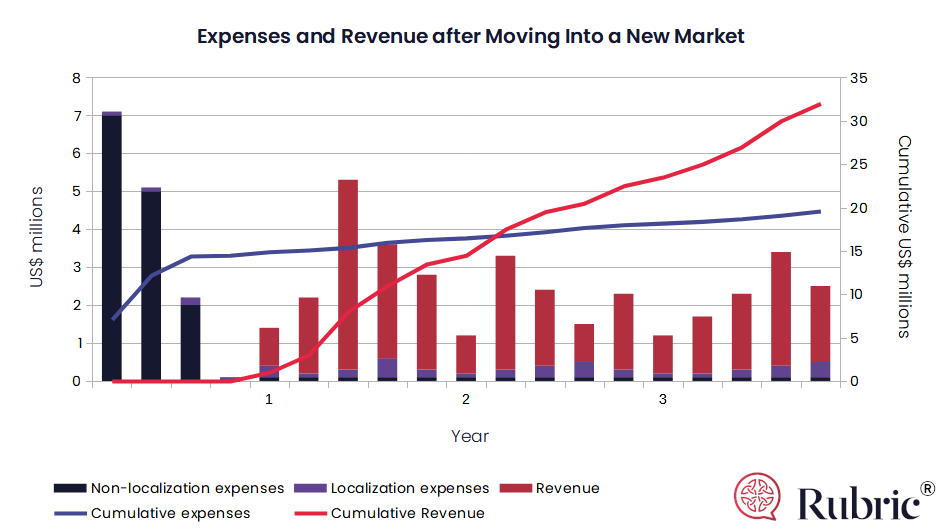
How can you tell if your translated content is worth the money you put into it?
Is it even possible to calculate the return on investment (ROI) of translation activities? Or is translation just a fixed cost?
Maybe you need to generate figures for your boss that show that investing in new translations is a good idea. Or maybe you have to justify your existing spending to your company.
Whatever your motivation, calculating the ROI of your translated content gives you an objective measure of how well your translations are working in your international markets. This gives you much more control and visibility over the whole translation process.
Here’s how to calculate the translation ROI for your global business…
How much does translation cost?
Translation cost is often quoted in terms of the misleading figure “cost per word” for a particular language pair. For example, one provider might quote $0.20 per word to translate from English into German while another quotes $2.30. Both figures obscure the real cost of translation.
The problem is that people often think of translation as a fixed cost for their business. They assume that they simply need to allocate a certain budget for translating their content. This makes the apparent simplicity of cost per word tempting.

This perception is understandable. But, it is a flawed way to think about translation.
Approaching translation as a fixed cost also makes it difficult — or even impossible — to calculate the ROI of translation.
We encourage companies to instead think of translation as a revenue driver.
What is ROI in business?
In business, the return on investment (ROI) is used to calculate the extra financial returns that are gained after making a particular investment in the business. The investment will have a positive ROI if the returns are higher than the associated costs.
ROI is usually associated with variable costs in the business. These are those costs that change depending on how much the company produces or sells — in other words, the company’s revenue drivers.
When you approach translation as a revenue driver, you can calculate the ROI in a similar way that you would calculate it for any other investment into your products or services.
Generate revenue from your translation budget
How can translation be a revenue driver?
To understand this perspective, ask yourself this question… What would happen if we didn’t translate any of our content?
Without translated content, your products or services would likely perform badly in foreign markets. According to a survey of consumers in 29 countries, 65% of consumers prefer content in their own language over English and 40% of customers won’t buy untranslated products.
How much revenue are you missing out on if 40-65% of people choose your competitors that do translate content?
Translation can be a powerful tool to help you reach those extra people.
According to CSA research, there are two key perspectives to think about when considering the ROI of translation:
- Potential future revenue in a new market — What extra revenue will well-localized content bring to you? This could be due to increased sales or it could be improving the efficiency of operations in your international markets (for example by reducing support calls thanks to translated documentation).
- The costs associated with localization — How much will it cost to localize your content? There are many ways to improve the efficiency of the localization process so this is an area where you can improve your ROI even more.

How to calculate the translation ROI for your business
The calculation for ROI is theoretically simple.
You first calculate the extra return you get from your translated content. You then divide this by the cost of translating that content.
However, in practice, the calculation is not so straightforward.
Every company is different, every market is different, and every language is different. The extra revenue you will be able to generate from your translated content will depend on a multitude of factors that are specific to your business. Also, the impact on revenue will likely be most visible in the longer term.
One way to get a helpful view of translation ROI is to create a graph that tracks the expenses of localization against the revenue in a particular market.
To create such a graph, do the following:
- Plot the cumulative cost for localization and non-localization expenses associated with moving into a new market. Project these data forward over a few years. Include projections for localization costs caused by future activities in this market, such as product releases.
- Plot the cumulative revenue in the market over this same time period.
- Identify the point on this graph where there is a positive ROI. This occurs when the expenses line crosses over the revenue line. How far in the future is this? (in our example below, this happens at the start of year 2)

If you are using projections, you can use the associated graphs to make the case for improving translations in your new market. If you are using historic data, you can identify the real ROI for your existing translations.
If your translations don’t achieve a positive ROI in this calculation, you can likely improve the situation by improving the efficiency of your localization process. See our eBook for tips on streamlining your localization process.
The key to getting a positive ROI from translations
How can you prove that your translations are generating an ROI?
Track your data!
There are various metrics that you can use to track the cost of localization and the revenue generated.
Your translation provider will be able to help you track metrics such as “cost per locale” and “Translation Memory savings.” These will demonstrate the costs on the provider’s end of the process. However, you will still need to track metrics on your end to get the full picture.
If you would some help identifying the best localization metrics for your business, fill in this form and one of our strategists will be happy to give you some advice.